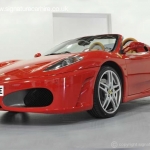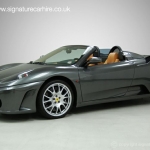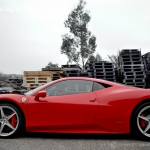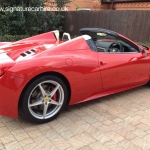Ferrari is arguably the granddaddy of modern supercars, and their success is all down to one man – Enzo Ferrari. Born in 1898, Enzo was to devote his whole life to designing and building sports cars.
Originally an Alfa Romeo driver, he founded Scuderia Ferrari in the late 1920s, which provided services for gentlemen who wanted to race their own cars. In 1939, Enzo went on to found Auto Avio Costruzioni, which produced the 1,500 cm³ 8-cylinder 815 Spider, used in the Mille Miglia race, just before WW2 forced a halt in production.
During the war, Ferrari moved to Maranello, and it was here it produced the first true Ferrari – the 1,500 cm³ 12-cylinder 125 S, which went on to win the Rome Grand Prix on the 25th May 1947. By this time Ferrari already had its legendary prancing horse symbol: the ‘Cavallino Rampante’, which had been a personal emblem of highly decorated WW1 pilot Francesco Baracca, who had it painted on the fuselage of his aircraft. Baracca’s family allowed Enzo to use the symbol, which he mounted on a yellow shield – to represent his hometown of Modena – and surmounted with the Italian flag. The classic Ferrari red, meanwhile, is derived from the standard Italian grand prix car colour of the early 20th century.
Ferrari’s racing success continued until the 1960s, when a dispute between Enzo’s wife Laura and sales manager Girolamo Gardini resulted in the departure of many staff, and tumult at Ferrari. Thanks to the expeditious hire of young engineer Mauro Forghieri, however, the company successfully completed the build of its 250 GTO – a car that became a racing icon and pushed Jaguar, who had been looking to compete with Ferrari, back into the shade. As well as track cars, Ferrari was also selling the Dino for road use, which proved incredibly popular in the early 60s. The Dino – the first mid-engined Ferrari – had superseded Ferrari’s early road models, which used coachwork by companies such as Pininfarina.
In 1969, Enzo sold 50% of the company to Fiat, who immediately pumped more funds into production and development. As the company moved into the 1970s, its racetrack efforts were concentrated around besting Porsche, which was winning most of the major races at the time. On the road, meanwhile, the company was developing cars such as the 365 Daytona, the 208, 308 and the more powerful Dino 246 GTS.
In 1973, Ferrari retired from sports car racing, having had limited success at events such as Le Mans, and concentrated on its flagging F1 effort. This effort was greatly aided by the redoubtable Niki Lauda, who won the world championship in 1975 and 1977. Unfortunately, as the company entered the 1980s, the team entered a period of crisis that culminated in the tragic death of Gilled Villeneuve in 1982.
On the road, Ferrari was going from strength to strength, and had even introduced cars such as the Mondial, which had a 2+2 seating layout. They also introduce a mid-mounted flat-12 engine model in the form of the Berlinetta Boxer, which was later replaced by the Testarossa. The late 1980s saw Ferrari once again return to producing supercars, first with the powerful 288 GTO, and then with the live-changingly gorgeous Ferrari F40, which is widely acknowledged as one of the most famous supercars ever made. The F40’s launch was overseen by Enzo, and was the last car to be launched before his death in 1988 – it certainly lived up to his wish to leave a legacy in his final supercar.
With Enzo’s death Fiat took an even larger stake in the company. The 1990s proved to be a glorious decade for Ferrari, thanks to the development of iconic roadcars such as the F355, a successor to the F40 – the F50 -, and the return to F1 greatness thanks to the genius of Michael Schumacher. The latter’s dominance continued into the next century, and successive F1 wins were paired with even more popular roadcars such as the F430 – bearing perhaps some of the most iconic wing mirrors of all time.
The most important development in this new decade was undoubtedly the Enzo. This supercar was Ferrari’s fastest model at the time and was originally going to be called the F60, but Ferrari were so proud of it that they decided to name it after the company’s founder. Only four hundred Enzo models were made and the 400th was donated to the Vatican for charity. Buying a second hand Enzo at auction in the market today will cost you several million pounds.
Today, as always, the incredible thing about Ferrari is that it has a knack of producing ever more beautiful cars that are ever more powerful. You only have to look at recent models such as the 599, the California and the new LaFerrari to witness the breathtaking power of their cars. See any of the marque’s incredible models and you’ll instantly see why Jeremy Clarkson said: “ I’d like to consider Ferrari as a scaled down version of God”.
When you drive a Ferrari, you’re not only taking part in a history that has seen over 5,000 race victories, 15 F1 titles and 16 F1 constructor’s titles, but you are also driving the product of immense passion – something that shines through with every movement at the wheel. There are many reasons that Ferrari is THE supercar manufacturer, and to truly understand them there is no alternative but to drive one for yourself which can be achieved easily with Signature Car Hire’s range of Ferrari hire cars.




